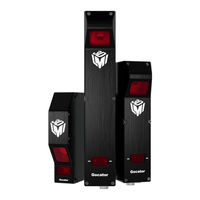LMI Technologies Gocator 2300 Series Manuals
Manuals and User Guides for LMI Technologies Gocator 2300 Series. We have 7 LMI Technologies Gocator 2300 Series manuals available for free PDF download: User Manual, Setup Manual, Quick Start Manual
LMI Technologies Gocator 2300 Series User Manual (800 pages)
Line Profile Sensors
Brand: LMI Technologies
|
Category: Accessories
|
Size: 41 MB
Table of Contents
Advertisement
LMI Technologies Gocator 2300 Series User Manual (533 pages)
Profile Sensors
Brand: LMI Technologies
|
Category: Security Sensors
|
Size: 25 MB
Table of Contents
LMI Technologies Gocator 2300 Series User Manual (523 pages)
Profile Sensors
Brand: LMI Technologies
|
Category: Accessories
|
Size: 24 MB
Table of Contents
Advertisement
LMI Technologies Gocator 2300 Series User Manual (431 pages)
Line Profile 3D Smart Sensors/Laser Profilers
Brand: LMI Technologies
|
Category: Accessories
|
Size: 22 MB
Table of Contents
LMI Technologies Gocator 2300 Series User Manual (369 pages)
Gocator 2000/2300 Series
Brand: LMI Technologies
|
Category: Accessories
|
Size: 26 MB
Table of Contents
LMI Technologies Gocator 2300 Series Setup Manual (13 pages)
4.x Dual-Sensor
Brand: LMI Technologies
|
Category: Security Sensors
|
Size: 1 MB
Table of Contents
LMI Technologies Gocator 2300 Series Quick Start Manual (2 pages)
Brand: LMI Technologies
|
Category: Security Sensors
|
Size: 1 MB






